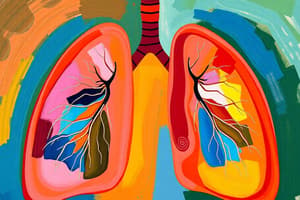Podcast
Questions and Answers
What is the primary cause of hypoxemia in pneumonia?
What is the primary cause of hypoxemia in pneumonia?
- Increased lung compliance
- Respiration in the pleural cavity
- Enhanced gas exchange in inflamed areas
- Increased shunting of blood to non-ventilated areas (correct)
What is the role of fibrin and edema in pneumonia?
What is the role of fibrin and edema in pneumonia?
- To decrease lung compliance and vital capacity (correct)
- To promote blood flow to alveoli
- To facilitate gas exchange
- To increase lung compliance
Which phase of pneumonia is characterized by the movement of RBCs and fibrin into the alveoli?
Which phase of pneumonia is characterized by the movement of RBCs and fibrin into the alveoli?
- Inflammatory phase
- Red hepatization phase (correct)
- Gray hepatization phase
- Resolution phase
Which organism is most commonly associated with community-acquired pneumonia?
Which organism is most commonly associated with community-acquired pneumonia?
What complication can result if the infection extends into the pleural cavity?
What complication can result if the infection extends into the pleural cavity?
Which of the following is NOT a common risk factor for hospital-acquired pneumonia?
Which of the following is NOT a common risk factor for hospital-acquired pneumonia?
What effect does pneumonia have on the compliance of the lungs?
What effect does pneumonia have on the compliance of the lungs?
Which patient characteristic increases the risk of aspiration pneumonia?
Which patient characteristic increases the risk of aspiration pneumonia?
What is a common early sign of confusion in older adults experiencing respiratory issues?
What is a common early sign of confusion in older adults experiencing respiratory issues?
Which of the following is a direct cause of Acute Lung Injury (ALI)?
Which of the following is a direct cause of Acute Lung Injury (ALI)?
Which symptom indicates possible involvement of the accessory muscles during respiratory distress?
Which symptom indicates possible involvement of the accessory muscles during respiratory distress?
What distinguishes ARDS from ALI?
What distinguishes ARDS from ALI?
What does E-A egophony indicate during a respiratory examination?
What does E-A egophony indicate during a respiratory examination?
Which of the following is an indirect cause of ALI?
Which of the following is an indirect cause of ALI?
In a patient with decreased oxygen saturation, which of the following symptoms may be present?
In a patient with decreased oxygen saturation, which of the following symptoms may be present?
What is the most common cause of Acute Lung Injury?
What is the most common cause of Acute Lung Injury?
What is the primary function of the Ventral Respiratory Group (VRG)?
What is the primary function of the Ventral Respiratory Group (VRG)?
What causes an obstructive pulmonary problem according to the general pathology?
What causes an obstructive pulmonary problem according to the general pathology?
Which statement accurately describes the changes in pulmonary function tests (PFT) associated with severe obstructive disease?
Which statement accurately describes the changes in pulmonary function tests (PFT) associated with severe obstructive disease?
What is the primary pathological change in emphysema?
What is the primary pathological change in emphysema?
What role do peripheral chemoreceptors play in respiratory regulation?
What role do peripheral chemoreceptors play in respiratory regulation?
How do inspiratory 'Ramp' signals affect lung filling?
How do inspiratory 'Ramp' signals affect lung filling?
What are the consequences of alveolar destruction in emphysema?
What are the consequences of alveolar destruction in emphysema?
Which accessory organ is primarily responsible for the secretion of digestive enzymes into the duodenum?
Which accessory organ is primarily responsible for the secretion of digestive enzymes into the duodenum?
What is the primary function of the villi in the mucosa layer of the digestive tract?
What is the primary function of the villi in the mucosa layer of the digestive tract?
What is typically the most common cause of intussusception in the small bowel?
What is typically the most common cause of intussusception in the small bowel?
What is consistent with restrictive disease characterized by pulmonary function tests?
What is consistent with restrictive disease characterized by pulmonary function tests?
Which clinical manifestation is characteristic of upper gastrointestinal bleeding?
Which clinical manifestation is characteristic of upper gastrointestinal bleeding?
Which layer of the digestive tract contains the submucosal plexus?
Which layer of the digestive tract contains the submucosal plexus?
What commonly causes acute pancreatitis related to alcohol consumption?
What commonly causes acute pancreatitis related to alcohol consumption?
What distinguishes exocrine glands from endocrine glands?
What distinguishes exocrine glands from endocrine glands?
Which of the following is NOT a component of the innermost tunic of the digestive tract?
Which of the following is NOT a component of the innermost tunic of the digestive tract?
Which of the following is a potential cause of lower gastrointestinal bleeding?
Which of the following is a potential cause of lower gastrointestinal bleeding?
What is the primary movement facilitated by the outer layer of longitudinal smooth muscle in the muscularis layer?
What is the primary movement facilitated by the outer layer of longitudinal smooth muscle in the muscularis layer?
What is a common clinical manifestation of ileus?
What is a common clinical manifestation of ileus?
What is a common etiology for superficial mucosal ulcers?
What is a common etiology for superficial mucosal ulcers?
What clinical manifestation is NOT typically associated with gastroparesis?
What clinical manifestation is NOT typically associated with gastroparesis?
Which structure forms a double layer of peritoneum that supports the intestines?
Which structure forms a double layer of peritoneum that supports the intestines?
What is the primary component of gallstones in cholelithiasis?
What is the primary component of gallstones in cholelithiasis?
What is the main role of the enteric nervous system in the digestive tract?
What is the main role of the enteric nervous system in the digestive tract?
Which type of bowel obstruction is most associated with a twisted loop of intestines?
Which type of bowel obstruction is most associated with a twisted loop of intestines?
Which type of hiatal hernia is the most common?
Which type of hiatal hernia is the most common?
What is a consequence of chronic hyperglycemia in the context of gastroparesis?
What is a consequence of chronic hyperglycemia in the context of gastroparesis?
What is the typical dilation measurement indicating a bowel obstruction?
What is the typical dilation measurement indicating a bowel obstruction?
Which of the following is NOT a treatment method for peptic ulcer disease?
Which of the following is NOT a treatment method for peptic ulcer disease?
What type of clinical manifestations are typically associated with a hiatal hernia?
What type of clinical manifestations are typically associated with a hiatal hernia?
What is a key characteristic of peptic ulcer disease compared to gastritis?
What is a key characteristic of peptic ulcer disease compared to gastritis?
Which of the following factors is NOT a known trigger for superficial mucosal ulcer development?
Which of the following factors is NOT a known trigger for superficial mucosal ulcer development?
Flashcards
Ventral Respiratory Group (VRG)
Ventral Respiratory Group (VRG)
The primary inspiratory center in the brain stem, which doesn't change its basic rhythm, only the pattern.
Inspiratory Ramp
Inspiratory Ramp
A gradual increase in inspiratory neuron firing, causing smooth lung filling instead of gasping breaths.
Central Chemoreceptors
Central Chemoreceptors
Brain receptors sensitive to increasing CO2 and H+ levels in the blood, triggering a breathing response.
Peripheral Chemoreceptors
Peripheral Chemoreceptors
Signup and view all the flashcards
Obstructive Pulmonary Problems
Obstructive Pulmonary Problems
Signup and view all the flashcards
Emphysema Pathology
Emphysema Pathology
Signup and view all the flashcards
Restrictive Lung Disease
Restrictive Lung Disease
Signup and view all the flashcards
Severe Obstructive Disease
Severe Obstructive Disease
Signup and view all the flashcards
Pneumonia Pathophysiology
Pneumonia Pathophysiology
Signup and view all the flashcards
Pneumonia Triggers (Community-Acquired)
Pneumonia Triggers (Community-Acquired)
Signup and view all the flashcards
Pneumonia Triggers (Hospital-Acquired)
Pneumonia Triggers (Hospital-Acquired)
Signup and view all the flashcards
Bacterial Pneumonia
Bacterial Pneumonia
Signup and view all the flashcards
Lung Compliance
Lung Compliance
Signup and view all the flashcards
Hypoxemia in Pneumonia
Hypoxemia in Pneumonia
Signup and view all the flashcards
Aspiration Pneumonia
Aspiration Pneumonia
Signup and view all the flashcards
Septicemia
Septicemia
Signup and view all the flashcards
ALI/ARDS Symptoms
ALI/ARDS Symptoms
Signup and view all the flashcards
ALI Pathophysiology
ALI Pathophysiology
Signup and view all the flashcards
ALI/ARDS Causes (Direct)
ALI/ARDS Causes (Direct)
Signup and view all the flashcards
ALI/ARDS Causes (Indirect)
ALI/ARDS Causes (Indirect)
Signup and view all the flashcards
ARDS Definition
ARDS Definition
Signup and view all the flashcards
ALI Definition
ALI Definition
Signup and view all the flashcards
Decreased Resonance
Decreased Resonance
Signup and view all the flashcards
Increased Fremitus
Increased Fremitus
Signup and view all the flashcards
Mucosal Ulcers
Mucosal Ulcers
Signup and view all the flashcards
NSAID Ulcer Cause
NSAID Ulcer Cause
Signup and view all the flashcards
Gastroparesis Etiology
Gastroparesis Etiology
Signup and view all the flashcards
Gastroparesis Symptoms
Gastroparesis Symptoms
Signup and view all the flashcards
Hiatal Hernia Types
Hiatal Hernia Types
Signup and view all the flashcards
Hiatal Hernia Cause
Hiatal Hernia Cause
Signup and view all the flashcards
Peptic Ulcer Location
Peptic Ulcer Location
Signup and view all the flashcards
Ulcer Bleeding Risk
Ulcer Bleeding Risk
Signup and view all the flashcards
Accessory Digestive Organs
Accessory Digestive Organs
Signup and view all the flashcards
Exocrine Pancreas Function
Exocrine Pancreas Function
Signup and view all the flashcards
GI Tract Layers
GI Tract Layers
Signup and view all the flashcards
Mucosa Layer Function
Mucosa Layer Function
Signup and view all the flashcards
Submucosa Layer Function
Submucosa Layer Function
Signup and view all the flashcards
Muscularis Layer Description
Muscularis Layer Description
Signup and view all the flashcards
Serosa Layer Role
Serosa Layer Role
Signup and view all the flashcards
Enteric Nervous System
Enteric Nervous System
Signup and view all the flashcards
Bowel Obstruction
Bowel Obstruction
Signup and view all the flashcards
Transition Point (bowel)
Transition Point (bowel)
Signup and view all the flashcards
Upper GI bleed
Upper GI bleed
Signup and view all the flashcards
Lower GI bleed
Lower GI bleed
Signup and view all the flashcards
Acute Pancreatitis
Acute Pancreatitis
Signup and view all the flashcards
Cholelithiasis
Cholelithiasis
Signup and view all the flashcards
Ileus
Ileus
Signup and view all the flashcards
Types of Bowel Obstructions
Types of Bowel Obstructions
Signup and view all the flashcards
Study Notes
Pulmonary Volumes and Capacities
- Tidal Volume (TV): Volume of air inhaled and exhaled with each normal breath, approximately 500 mL.
- Minute Volume: Volume of air inhaled and exhaled in one minute, calculated by multiplying TV by respiratory rate (about 8L).
- Alveolar Volume: Difference between TV and dead space volume (about 350 mL).
- Inspiratory Reserve Volume (IRV): Extra volume of air that can be inhaled beyond normal tidal volume (about 3000 mL). It's a measure of pulmonary compliance and inspiratory muscle strength. Reduced IRV suggests reduced lung compliance or weakened inspiratory muscles.
- Expiratory Reserve Volume (ERV): Volume of air that can be forcefully exhaled after a normal tidal inhalation (about 1100 mL). Increased ERV indicates improved expiratory muscle strength; decreased ERV suggests weaker muscles, airway obstruction, or restrictive disorders.
- Residual Volume (RV): Volume of air remaining in the lungs after the most forceful exhalation (about 1200 mL). Increased RV can be an indicator of aging or reduced ventilation effectiveness.
- Forced Expiratory Flow (FEF) / Peak Expiratory Flow (PEF): Airflow rate during forced expiration. Reductions greater than 25% of PEFR are suggestive of obstructive respiratory disorders.
- Forced Expiratory Volume 1 (FEV1): Maximum volume of air that can be forcefully exhaled in the first second after maximal inhalation (normally 80% of average). This is a sensitive measure for obstructive airway disorders.
- Diffusing Capacity of the Lung for Carbon Monoxide (DLCO): Measures how well gas moves from the alveoli into the blood. Lower DLCO values suggest alveolar problems like emphysema, pneumonia, or pulmonary edema.
Pulmonary Capacities
- Inspiratory Capacity (IC): Volume of air that can be inspired from rest to the maximum possible level, equal to 3500 mL (Tidal Volume + Inspiratory Reserve Volume). Reduced IC suggests restrictive lung disease.
- Functional Residual Capacity (FRC): Volume of air remaining in the lungs at the end of a normal tidal breath, equal to 2300mL (Expiratory Reserve Volume + Residual Volume). Increases suggest obstructive lung diseases.
- Vital Capacity (VC): Maximum volume of air that can be expelled from the lungs after maximum inhalation, equal to 4600 mL (Inspiratory Reserve Volume + Tidal Volume + Expiratory Reserve Volume).
- Total Lung Capacity (TLC): Maximum volume of air lungs can hold equal to 6 liters (Tidal Volume + Inspiratory Reserve Volume + Expiratory Reserve Volume + Residual Volume). Reduced TLC suggests restrictive disease. Forced Vital Capacity (FVC) is the maximum volume of air exhaled as rapidly as possible after maximal inhalation.
Pulmonary Functions
- Ventilation: Movement of air into and out of lungs for gas exchange.
- Perfusion: Circulation of blood through tissues and organs for gas exchange.
- Diffusion: Movement of O2 and CO2 molecules across permeable membranes due to pressure differences.
- Regulation of oxygenation and gas exchange: Vital function of lungs
- Protection: Lungs defend against pathogens and irritants, mainly by macrophages and surfactant.
- Maintenance of cardiac output: Function of the lungs to support cardiac function and blood pressure.
- Immunity: Lungs role in immune defense.
- Fluid, electrolyte, and acid-base balance: Lungs play a minor role in these processes.
Other Pulmonary Information
- Anatomic Dead Space: Volume of airways where gas exchange cannot occur, usually 150 mL
- Physiological Dead Space: Total volume of airways where gas exchange cannot occur. Includes anatomical dead space plus additional areas of non-functional tissue.
Studying That Suits You
Use AI to generate personalized quizzes and flashcards to suit your learning preferences.



